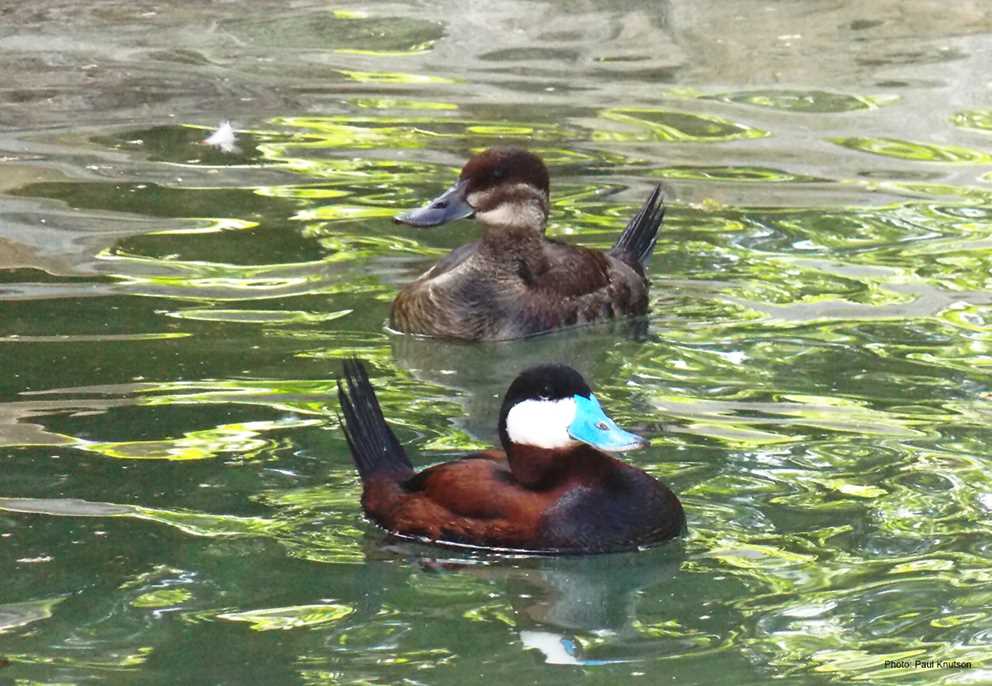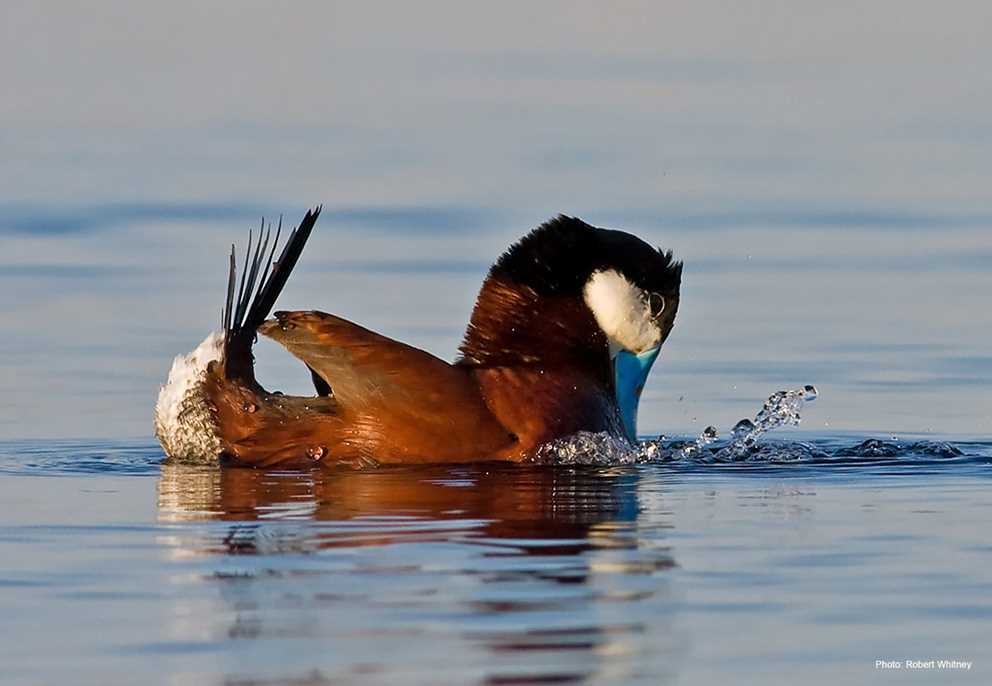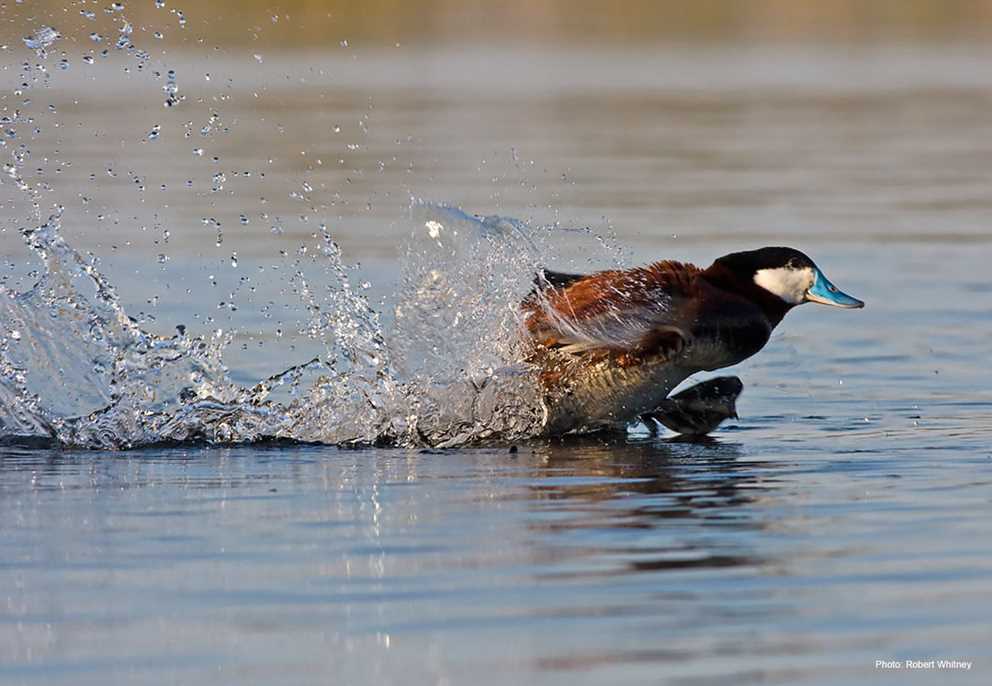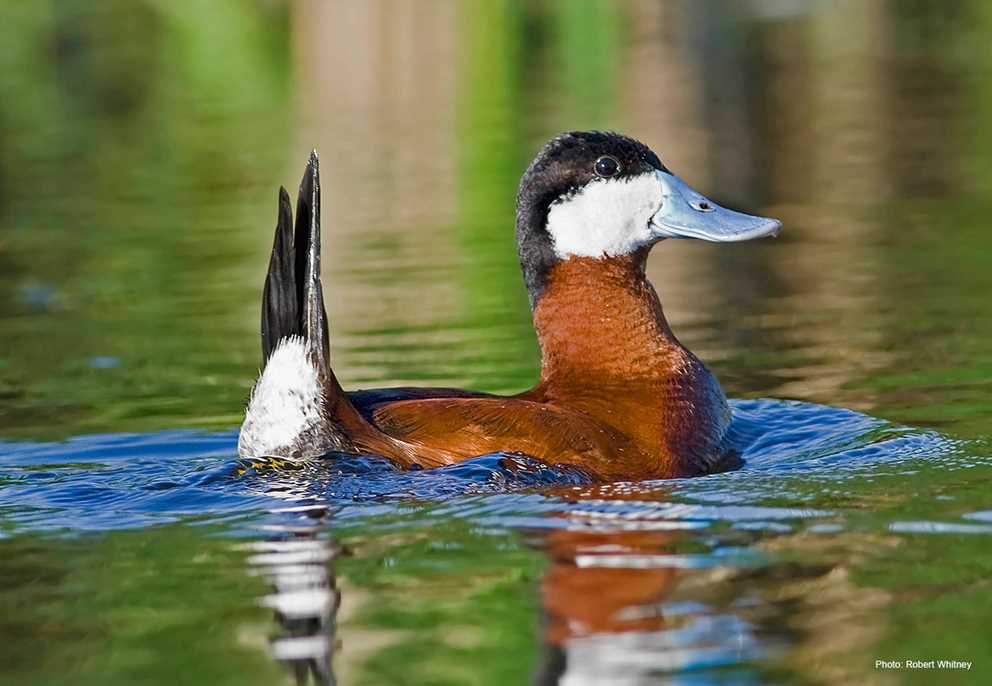Overview
The Ruddy Duck is a small, diving duck with migratory and nonmigratory populations in North America and the Caribbean Islands, but the core of their breeding range is in the Prairie Pothole Region of North America, where an estimated 86 percent of the breeding population occurs. Smaller breeding populations occur in Alaska, the Intermountain West, Southern Great Plains, and the Great Lakes. Relatively small non-migratory populations breed in the Intermountain West (southern latitudes), Central and Southern California, northern and western Mexico, and some Caribbean Islands.
They are one of the two “stiff-tail” ducks, the other being the Masked Duck, which occur in North America. Males in alternate plumage are reddish brown overall, with the head having a black crown extending to the eyeline and down the back of the neck and a distinct white cheek patch, bright pale blue bill with a dark tip, and a dark gray black tail. Females and young males are pale gray brown overall, darker gray brown on the back, have a dark crown, and a notable dark stripe on the pale cheek below the eye.
Description
Key Identification Features
- Males in alternate plumage are reddish brown overall with the head having a black crown down to the eyeline and down the back of the neck with a distinct white facial patch from the base of the bill below and behind the eye down to the neck and a bluish-gray bill with a black tip.
- Adult males in basic plumage are brown-gray, retain a dark gray brown crown, a white cheek patch, and have dark gray bills.
- Females and juveniles are dusky gray-brown overall, the head has a dark crown extending to just below the eye, a pale buffy cheek patch with a notable dark stripe below the eye, and the bill is dark gray.
- In flight, they are compact, small ducks with short dark upper wings that flash light gray on the underwings.
Male/Female Average Length and Weight
- Weight: Males 1.1–1.4 lbs.; Females 1.1–1.8 lbs.
- Wingspan: Males 5.8–6.3 in.; Females 5.2–6.1 in.
Male Identification
- Alternate (Breeding) Plumage: Males in alternate plumage are reddish-brown overall, the head has with a black crown extending to the eyeline and down the back of the neck with a distinct white cheek patch, bright pale blue bill with a dark tip, and a black tail.
- Basic Plumage: Plumages are fairly similar between the sexes being overall brownish-gray, darker on the back, with a light gray belly. The head has a dark crown and dark gray bill with males retaining the white facial patch.
Female Identification
- Alternate (Breeding) Plumage: The head has a dark crown, and a lighter cheek patch with a dark stripe below the eye dark gray bill.
- Basic Plumage: Similar to male basic plumage but females retain the dark facial stripe below the eye.
In-flight Identification
- In flight, they are compact, small ducks with short wings showing dark on the upper surface with lighter gray underwings, and grayish bellies.
Vocalizations
- Typically silent. During courtship males utter a belching sound during the Bubbling Display. Females may give an alarm “raanh” to broods.
Similar Species
- Masked Ducks: In North America, males in alternate plumage are unmistakable. Young birds, females, and males in basic plumage may be confused with Masked Ducks, a rare to uncommon bird of South Texas, (rarely in Louisiana and Florida). Masked Ducks have two stripes on the face—through the eye and below the eye on the cheek, whereas Ruddy Duck females and young birds will have only one facial strip. Adult male Ruddy Ducks will have a pale cheek with no stripes. In alternate plumage Masked Ducks have a namesake black facial mask, while Ruddy Ducks have a bright white cheek patch.
Habitat Preferences
- Breeding: Ruddy Ducks use prairie pothole wetlands, with a tendency towards using the more semi-permanent wetlands, larger marshes with lots of emergent vegetation.
- Winter: During the winter they use large lakes, reservoirs, stock ponds, and fresh to saline coastal marshes and bays.
Forging Habits and Diet
- Breeding Season: Birds forage by diving almost exclusively on invertebrates including midge larvae and small crustaceans.
- Migration and Winter: Outside of the breeding season the diet is variable with habitat use, ranging from various parts of aquatic plants to invertebrates.
Breeding Habits
- Monogamy: Primarily seasonally monogamous, but some polygynous males documented with up to three females. Males have a unique courtship display referred to as the Bubbling Display. Pair bonds are formed on the breeding areas, and the bond breaks during early incubation.
- Nest Location: The nest is usually over water in dense emergent vegetation. Females build nests mostly with dead, dry vegetation from the previous year, making a platform and eventually shaping a shallow nest bowl.
- Clutch Size: 7 to 9 eggs, with nest parasitism occasionally resulting in abnormally large clutches. Female Ruddy Ducks lay the largest egg relative to body size of all waterfowl. Assumed to nest at one year of age.
Migration and Distribution
- Fall Migration: Birds breeding in the Prairie Pothole Region depart breeding areas in August and September, with peak migration to wintering areas in September and October.
- Spring migration: Spring migration begins in February for birds wintering farthest south (Mexico), peaks in mid-March to April, with arrival on breeding areas in April and early May. Nonmigratory populations occur in Mexico and the Caribbean, and some local small populations in southern US portions of breeding range.
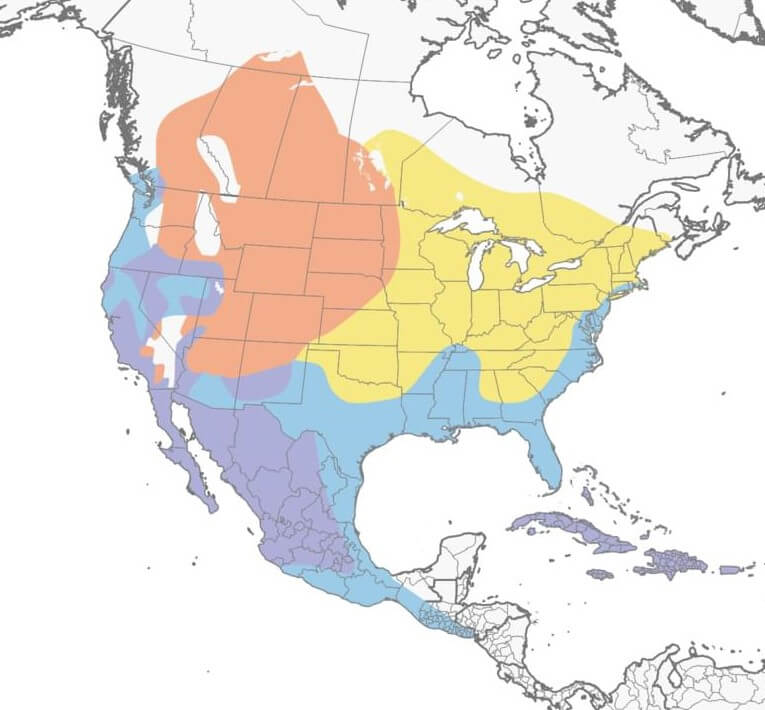
Conservation Status
- IUCN Status: Least Concern
- Population Status: The USFWS Waterfowl Population and Habitat Survey indicates a long-term average breeding population of 400,000–450,000.
- Conservation Concerns: Degradation of breeding habitats in the Prairie Pothole Region and wintering habitats in the Chesapeake Bay are primary areas of concern.
- Conservation Focus: Protecting and restoring habitats especially in the Prairie Pothole Region are important to support breeding populations.
Harvest Information
- An average of 27,676 Ruddy Ducks were harvested annually across the US from 2019 to 2022.
- Ruddy Duck harvest is typically highest in the Mississippi Flyway, accounting for 20 to 30 percent of the total US harvest.
- The top three states for Ruddy Duck harvest, based on annual averages across the 2019–2022 hunting seasons, were Wisconsin (6,632), California (4,414), and North Dakota (2,815).
